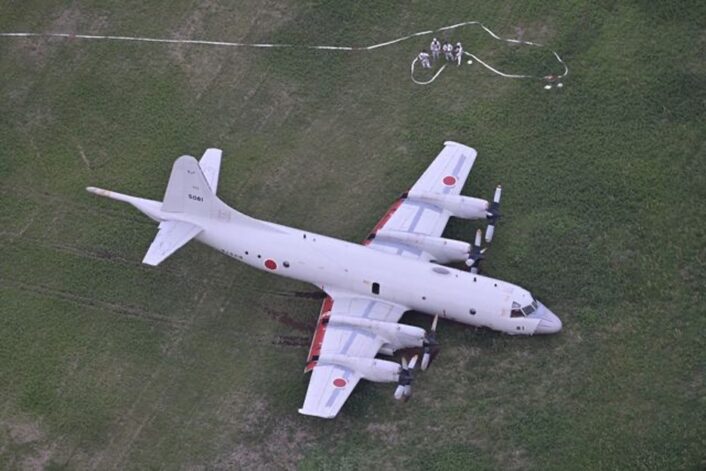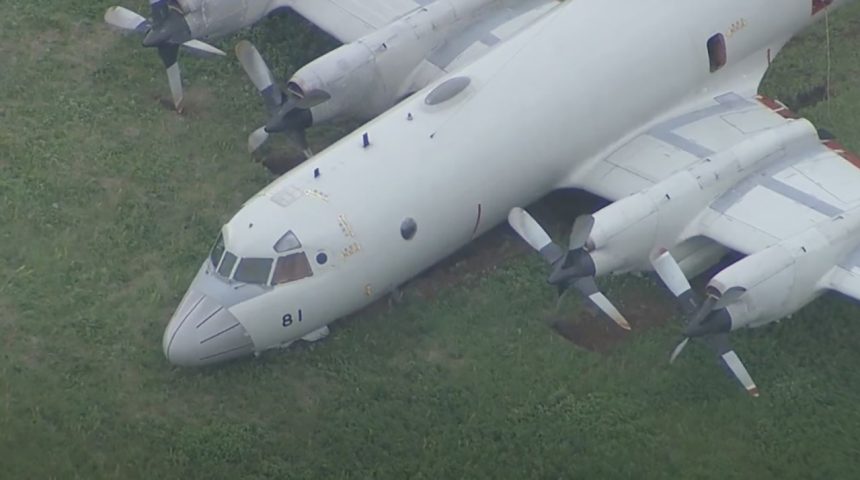Aircraft’s front landing gear possibly retracted after touchdown, causing it to veer off course.
A Japan Maritime Self-Defense Force (JMSDF) P-3C Orion maritime patrol aircraft skid off the runway during landing at an air base in the east of the country outside Tokyo, around 4:35 pm (local time) on May 8, 2024. The Asahi Shimbun reported that none of the 12 JMSDF personnel on board the aircraft were injured.
The plane came to a grinding halt on the grass, finally coming to rest perpendicular to the Shimousa Air Base’s runway, that straddles Kashiwa City and Kamagaya City.
The Mishap
The Asahi Shimbun said that civilian emergency services in Kashiwa city received a call from the JMSDF about the P-3C patrol aircraft that had “deviated from the runway.” The video carried by the report showed rescue personnel and fire trucks surrounding the aircraft, which was tilting forward with the nose scraping the ground. “According to the city’s Disaster Prevention and Safety Division, there was no fire or impact on the surrounding area.”
It quoted a statement from Japan’s Ministry of Defense, that said the plane “veered eastward from the runway when it landed at around 4:10 pm.” “There were 12 Maritime Self-Defense Force personnel on board, but no one was injured. Shimousa Air Base has one runway that is 2,250 meters long and 45 meters wide. It has units that train pilots and aviators,” it added.
Lockheed P-3C Orion – JMSDF(Japan Maritime Self Defense Force) pic.twitter.com/W6netWDcUe
— Thenewarea51 (@thenewarea51) September 2, 2021
Aviation Safety Network claimed that the incident took place during a “training” sortie, observing that the “nose gear seemed to be retracted.” “The Orion first veered off the runway 01 to the left slightly, rotating 90 degrees to the right to cross over the runway and stuck on the grass. Four propellers shaved the surface of the grass and soil at the point of rest,” it added.
Presumably, the front landing gear must have experienced a malfunction and given away or pushed back in, causing the nose to drop and hit the ground, with the plane eventually steering off course. This is based on a video claimed to be of the accident as it was coming into land, shot from the ground from the runway and close to the chain-link fence guarding the base.
事故寸前で停めちゃったんだよなぁ。 pic.twitter.com/kE6czwscDS
— ちぃ (@chi0203atlas) May 8, 2024
The video circulating online shows the plane landing off-axis, with first the rear and then the front landing gear touching down in sequential fashion. However, the video ends just as it appears that the nose too crashes on the ground and the plane is about to skid off the runway. It is not entirely clear if the clip is of the actual incident in question.
Frontline ASW & Maritime Surveillance Aircraft
The four-engined turboprop Lockheed Martin P-3C Orion is the JMSDF’s leading anti-submarine warfare (ASW) and MPA. According to Sea Forces, there are 93 P-3Cs in service in the JMSDF where the Kawasaki Aerospace Corporation (KAC) assembled and produced more than a 100 P-3Cs, under license in Japan. Japan has several variants besides the baseline production P-3C variant.

This includes the EP-3, an electronic intelligence (ELINT) for the JMSDF; the OP-3, which is a P-3C converted for maritime reconnaissance for the JMSDF; the UP-3C that is used by the JMSDF for testing equipment; and the UP-3D, another JMSDF used for ELINT roles. The aircraft has participated in exercises with friendly countries like Malaysia and India over the years.
It has also been used to track and photograph Chinese and Russian warships sailing or exercising around Japan’s waters. A March 3 post on X by a handle that tracks Japanese navy developments, showed a photograph of the Chinese aircraft carrier Liaoning, that was photographed “directly from above by the JMSDF’s P-3C.” The aircraft has an electro-optical turret under the chin for visual reconnaissance and surveillance.
Lockheed Martin describes the plane as a “peerless” long-range ASW and maritime patrol aircraft that set the global standard for “multi-mission long-endurance flights.” With a cruising range of 7,670-km, it also has advanced “information processing capabilities,” according to Kawasaki. This suggests the JMSDF Orions also are an important element in tactical coordination with other ground, surface, shore and air assets as an airborne data exchange platform.









